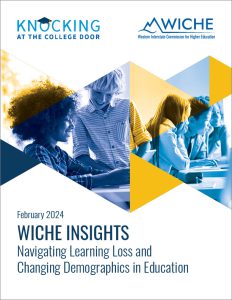
WICHE has released new analysis about the effect of pandemic-related K-12 learning loss on projections of high school graduates and suggests ways that postsecondary institutions can respond to support students.
This new brief coincides with the release of the Improving Student Achievement Agenda for 2024 calling on schools, districts, education stakeholders, and the broader community, to leverage strategies to reduce chronic absenteeism, increase tutoring, and expand learning programs to accelerate academic recovery in K-12 education. At the same time, the U.S. Department of Education extended flexibility for states to continue to use American Rescue Plan dollars in the 2024-2025 school year on academic support and again called on colleges and universities to use at least 15% of their federal work-study funds for college students employed in student support roles as begun through the National Partnership for Student Success.
For an overview, listen to this Tea for Teaching podcast, as report author Peace Bransberger, discusses the implications of the K-12 learning impacts for postsecondary institutions and faculty.
Key Takeaway
Learning disruption since the pandemic may have affected enough children and teens that a quantitative impact on high school graduation is plausible on top of previously projected declines in the number of high school graduates — and postsecondary enrollment declines it will bring to some sectors. And youth who do persist and enter college may need academic accommodations for pandemic learning impacts.
Unresolved learning impacts for current 11th and 12th graders could impact these predicted high points in the numbers of U.S. high school graduates.
The sobering data about 8th graders from the last several years could presage difficulties for these students to stay on pace in high school and amplify downturns already predicted by demographics.
It is too soon to predict whether elementary student learning loss could impact the high school graduate pipeline, but lingering issues suggest postsecondary might anticipate residual impacts.
What Can Be Done?
Immediate and ongoing action is needed, given the lingering pandemic impacts and the approaching substantial demographic shift, among other pressing factors. The last several years brought different postsecondary education patterns among young adults who experienced high school during the pandemic — not to mention other social-economic events and pressures over these years. Postsecondary institutions, systems, and states are understandably focused on recent sheer enrollment impacts and those to come.
What can they do to respond to the possible further impacts that learning loss might bring for postsecondary student populations?
Seek out detail about the state, district and school assessment results, college-going information and different student populations who are key to your student population. Some places to start:
- Interactive charts from education outlet The74 provide state-by-state views of 2022 NAEP math proficiency declines.
- The First Year of Pandemic Recovery: A District-Level Analysis and Data Explorer provide detailed indicators about academic gains from 2022 to 2023 and reveal where achievement disparities between poor and non-poor districts and students widened from 2019 to 2023.
- School, district and state chronic absenteeism map views, data profiles and data files, policy options and other detailed resources are available at Turning Back the Tide: The Critical Role of States in Chronic Absenteeism, from Attendance Works and Everyone Graduates Center at John Hopkins School of Education.
Watch the White House release of its “Improving Student Achievement Agenda for 2024”
Listen to American Council on Education’s dotEDU podcast (see more resources in the show notes)
Listen to FutureU podcasts Will the Teens Be OK? and Will the Kids be OK?
Watch the FutureEd webinar State Policy Solutions for Reducing Student Absenteeism (see also the attendance playbook and implementation guide)
Colleges can support K-12 schools and districts by providing tutoring or other assistance to help alleviate learning impacts and understand learning needs. For example:
The EdSurge article, Schools Are Desperate for Tutors. Can College Students Help?, describes available tutoring-specific “nanocourses” and work-study eligible ways that college students can be part of much-needed tutoring for K-12 students.
On-Track Indicators: A Powerful Data-Based Tool for Action from the Data Quality Campaign outlines ways statewide longitudinal data systems (SLDS) might be refined to support recovery. Virginia provides one such example in a Learning Needs Dashboard
The University of Virginia published COVID-related research briefs throughout the 2022-23 school year as part of a federal Institute of Education Sciences (IES) grant with the Virginia Department of Education.
Consider evaluating recruitment, admissions, scholarship and aid, enrollment and program pathway criteria and processes in light of the learning and proficiency impacts, and with a recognition that the student populations who are historically more disadvantaged also experienced some of the greatest pandemic learning impacts.
In anticipation of increased need for developmental education, review possibilities for reform such as those discussed in Incomplete: The Unfinished Revolution in College Remedial Education, from FutureEd Senior Fellow Anne Kim.
Be aware of the college preparation options available to students, including those who have had fewer options.
Provide support to current pandemic-impacted postsecondary students, and those to come, who may need additional academic or other supports.
Given the K-12 enrollment shifts to homeschooling, postsecondary institutions should also be aware of how to identify, recruit and assess homeschooled learners, and meet their unique expectations or needs.
